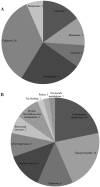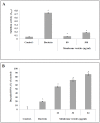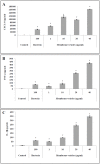Isolation, Characterization and Biological Properties of Membrane Vesicles Produced by the Swine Pathogen Streptococcus suis
- PMID: 26110524
- PMCID: PMC4482388
- DOI: 10.1371/journal.pone.0130528
Isolation, Characterization and Biological Properties of Membrane Vesicles Produced by the Swine Pathogen Streptococcus suis
Abstract
Streptococcus suis, more particularly serotype 2, is a major swine pathogen and an emerging zoonotic agent worldwide that mainly causes meningitis, septicemia, endocarditis, and pneumonia. Although several potential virulence factors produced by S. suis have been identified in the last decade, the pathogenesis of S. suis infections is still not fully understood. In the present study, we showed that S. suis produces membrane vesicles (MVs) that range in diameter from 13 to 130 nm and that appear to be coated by capsular material. A proteomic analysis of the MVs revealed that they contain 46 proteins, 9 of which are considered as proven or suspected virulence factors. Biological assays confirmed that S. suis MVs possess active subtilisin-like protease (SspA) and DNase (SsnA). S. suis MVs degraded neutrophil extracellular traps, a property that may contribute to the ability of the bacterium to escape the host defense response. MVs also activated the nuclear factor-kappa B (NF-κB) signaling pathway in both monocytes and macrophages, inducing the secretion of pro-inflammatory cytokines, which may in turn contribute to increase the permeability of the blood brain barrier. The present study brought evidence that S. suis MVs may play a role as a virulence factor in the pathogenesis of S. suis infections, and given their composition be an excellent candidate for vaccine development.
Conflict of interest statement
Figures






Similar articles
-
Purification and characterization of the subtilisin-like protease of Streptococcus suis that contributes to its virulence.Vet Microbiol. 2011 Mar 24;148(2-4):333-40. doi: 10.1016/j.vetmic.2010.09.024. Epub 2010 Oct 27. Vet Microbiol. 2011. PMID: 21030165
-
Understanding the virulence of Streptococcus suis: A veterinary, medical, and economic challenge.Med Mal Infect. 2018 May;48(3):159-166. doi: 10.1016/j.medmal.2017.10.001. Epub 2017 Nov 6. Med Mal Infect. 2018. PMID: 29122409 Review.
-
Identification of a cell wall-associated subtilisin-like serine protease involved in the pathogenesis of Streptococcus suis serotype 2.Microb Pathog. 2010 Mar-Apr;48(3-4):103-9. doi: 10.1016/j.micpath.2009.11.005. Epub 2009 Nov 26. Microb Pathog. 2010. PMID: 19944142
-
Virulence factors involved in the pathogenesis of the infection caused by the swine pathogen and zoonotic agent Streptococcus suis.Future Microbiol. 2012 Feb;7(2):259-79. doi: 10.2217/fmb.11.149. Future Microbiol. 2012. PMID: 22324994 Review.
-
IgA1 protease contributes to the virulence of Streptococcus suis.Vet Microbiol. 2011 Mar 24;148(2-4):436-9. doi: 10.1016/j.vetmic.2010.09.027. Epub 2010 Oct 30. Vet Microbiol. 2011. PMID: 21041043
Cited by
-
Comparative Exoproteome Analysis of Streptococcus suis Human Isolates.Microorganisms. 2021 Jun 12;9(6):1287. doi: 10.3390/microorganisms9061287. Microorganisms. 2021. PMID: 34204746 Free PMC article.
-
Identification and Characterization of IgdE, a Novel IgG-degrading Protease of Streptococcus suis with Unique Specificity for Porcine IgG.J Biol Chem. 2016 Apr 8;291(15):7915-25. doi: 10.1074/jbc.M115.711440. Epub 2016 Feb 9. J Biol Chem. 2016. PMID: 26861873 Free PMC article.
-
Proteomics of extracellular vesicles produced by Granulicatella adiacens, which causes infective endocarditis.PLoS One. 2020 Nov 20;15(11):e0227657. doi: 10.1371/journal.pone.0227657. eCollection 2020. PLoS One. 2020. PMID: 33216751 Free PMC article.
-
How Streptococcus suis escapes antibiotic treatments.Vet Res. 2022 Nov 12;53(1):91. doi: 10.1186/s13567-022-01111-3. Vet Res. 2022. PMID: 36371221 Free PMC article. Review.
-
Survival of Streptococcus suis in Porcine Blood Is Limited by the Antibody- and Complement-Dependent Oxidative Burst Response of Granulocytes.Infect Immun. 2020 Feb 20;88(3):e00598-19. doi: 10.1128/IAI.00598-19. Print 2020 Feb 20. Infect Immun. 2020. PMID: 31843967 Free PMC article.
References
-
- Mashburn LM, Whiteley M. Membrane vesicles traffic signals and facilitate group activities in a prokaryote. Nature. 2005;437(7057):422–5. - PubMed
Publication types
MeSH terms
Substances
LinkOut - more resources
Full Text Sources
Other Literature Sources
Medical

